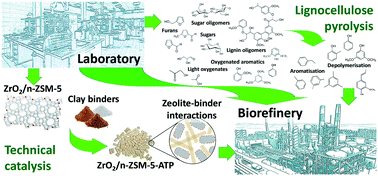The crucial role of clay binders in the performance of ZSM-5 based materials for biomass catalytic pyrolysis†
Abstract
The effect of the agglomeration of the ZrO2/n-ZSM-5 catalyst with two different clays (bentonite and attapulgite) on lignocellulose catalytic pyrolysis has been investigated. The reaction tests have been carried out with an “ex situ” configuration of the reaction system, which allowed the thermal and catalytic zones to operate at different temperatures (550 and 400 °C, respectively). The behavior of the agglomerated catalysts has been compared with those of the binder-free material and the pure clays. The catalyst samples have been characterized by X-ray diffraction, microscopy, chemical analysis and Ar adsorption measurements, as well as by FTIR of both adsorbed pyridine and CO2 to probe their acid–base properties. The occurrence of synergetic effects between the different catalyst components in the agglomerated materials has been denoted in lignocellulose catalytic pyrolysis. Agglomeration caused opposite effects on the catalyst performance depending on the clay. With bentonite as the binder, the technical catalyst showed a reduced bio-oil deoxygenation activity due to a loss of most of its strong acidity by ion-exchange of Na+ cations from the clay. However, the agglomerated catalyst incorporating attapulgite exhibited an enhanced activity leading to the production of a bio-oil with significantly lower oxygen content. For this system a migration of Mg2+ occurs from the attapulgite towards both the zeolitic and ZrO2 components of the parent catalyst. Although this fact partially decreases the concentration of the zeolite Brønsted acid sites, it also has a promotion effect on both Lewis acidity and basicity due to the interaction between the migrating Mg2+ species and the ZrO2 phase. As a result, the technical catalyst agglomerated with attapulgite exhibits a well-balanced distribution of acid and basic sites, which is responsible for the remarkable enhancement observed in the bio-oil deoxygenation activity in comparison with the binder-free material.



 Please wait while we load your content...
Please wait while we load your content...